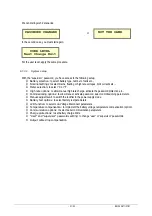
- 41 / 50 -
BN 09 2671/01/01
8.4.3 Battery temperature compensation – Plug-in type
The chargers can sense the battery ambient temperature. The sensor is located in a metal lug and can be mounted
to the wall, on the battery rack or inside the battery cabinet by a screw. The connection from sensor to board is a 4
wire telephone cable. The sensor is used to compensate the floating voltage or the high rate voltage if necessary
and is delivered with a 5m cable.
How to instal and activate this option on the control card : Refer to the option installation manual
8.4.4 Cable drop compensation
The rectifiers can be programmed (cable drop parameter) to compensate for cable voltage drop between the system
and the battery without the need of remote sensing.
If battery current limit/display option is present:
The output voltage will be increased as a function of the battery recharge current.
If battery current limit/display option is not present:
The output voltage will be increased as a function of the load current.
This option is used when load cables are connected to a common bus bar on which the battery and the load are
connected.
Voltage measurements on the display:
“Outp” (measurement menu): compensated voltage (value from calculation).
“DC” (default menu) and Load (measurement menu): actual voltage
Note: the cable drop parameter is the reverse function of “droop” factor used for passive load sharing.
Cable drop parameters setting procedure
:
Connect a load on the load output of the common DC bus.The load shall be as close as possible to the charger
nominal current to have a good adjustment accuracy.
Measure the voltage drop across the cables :
Δ
Umeasured = V1-V2
If the charger current during the test is different from its nominal value, calculate the equivalent voltage drop for
the nominal current :
Δ
Unominal =
Δ
Umeasured x charger nominal current / current during the measurement
Enter the
Δ
Unominal value in the control card and through the display following the procedure below :










































